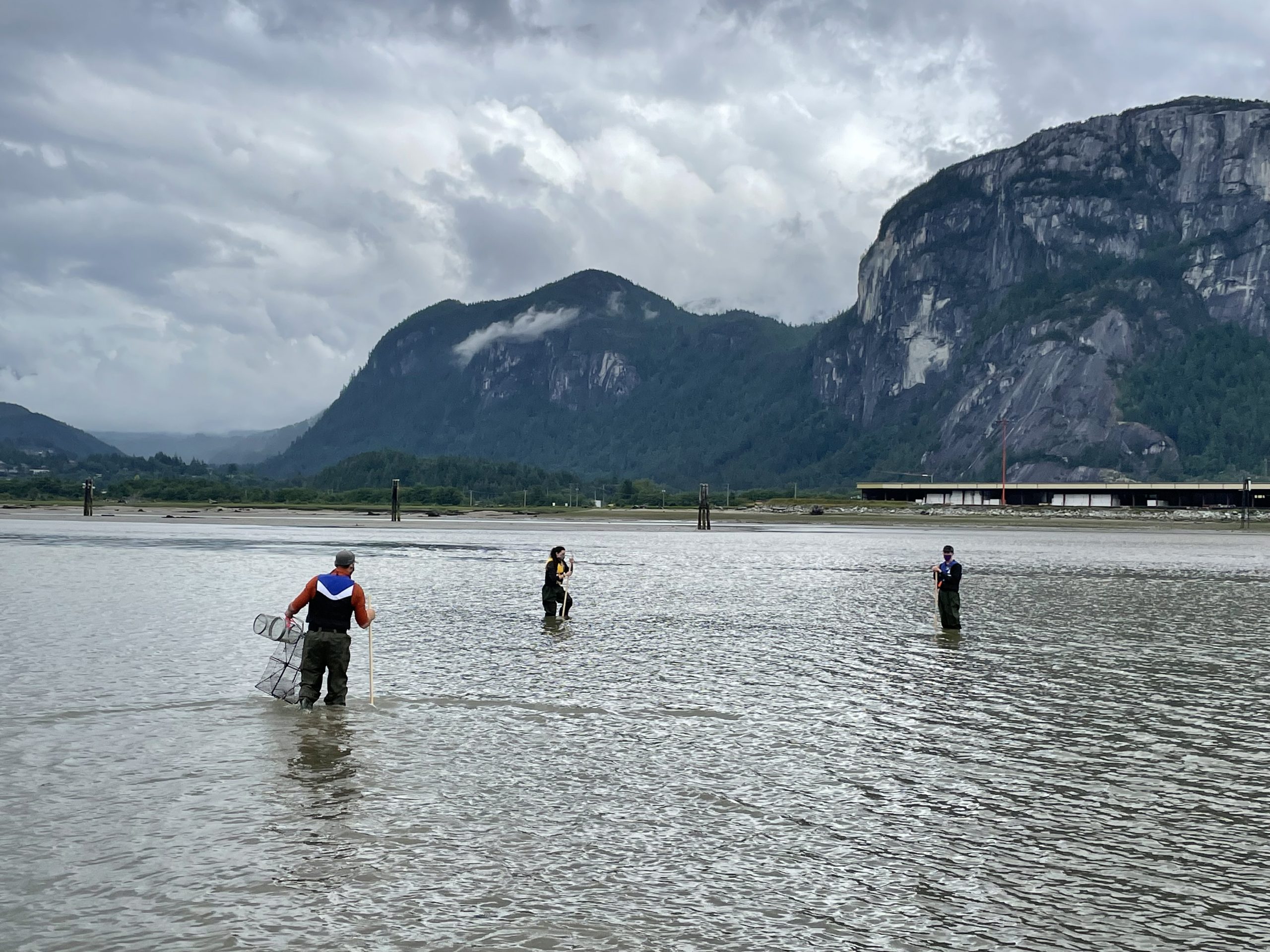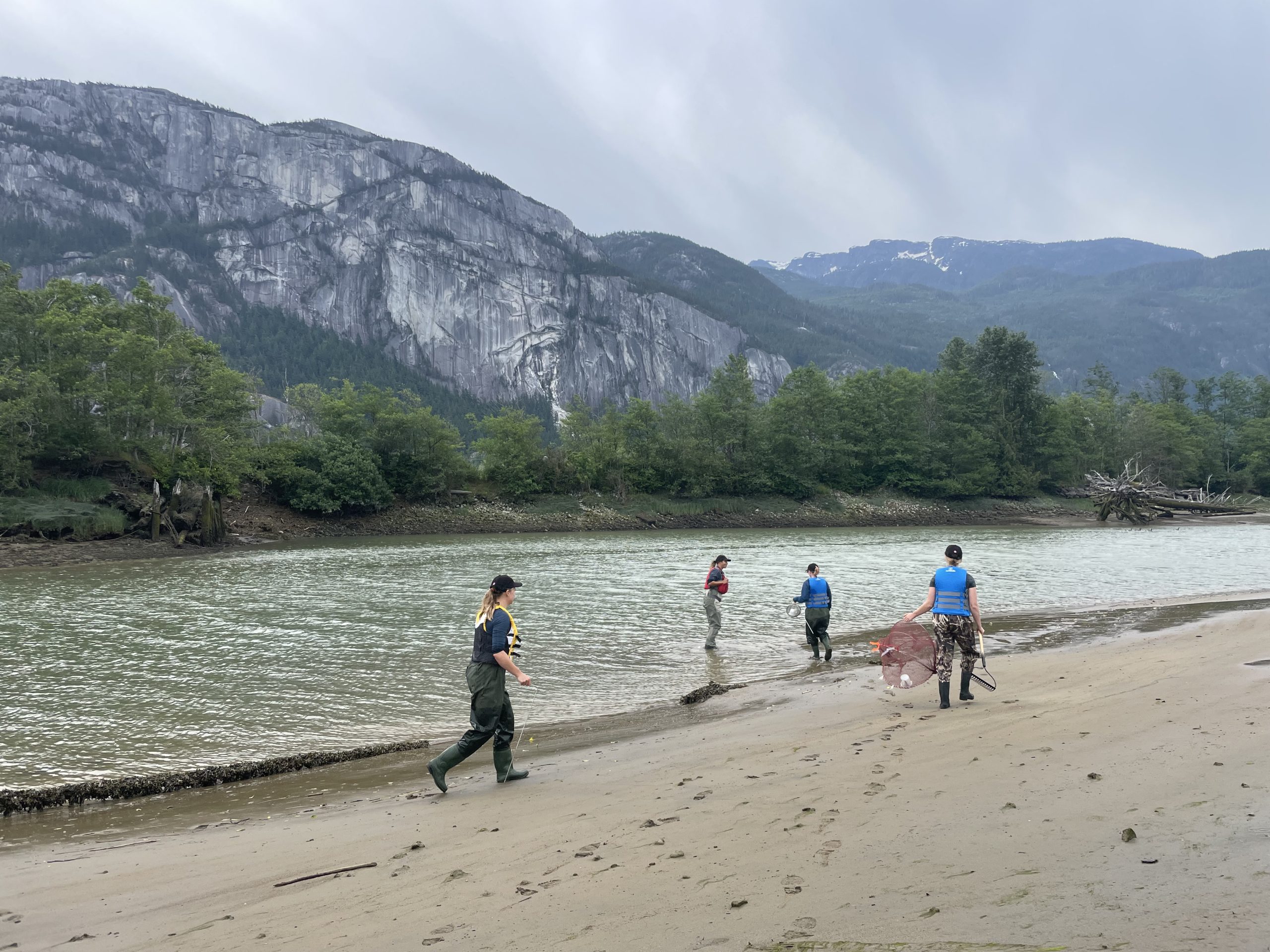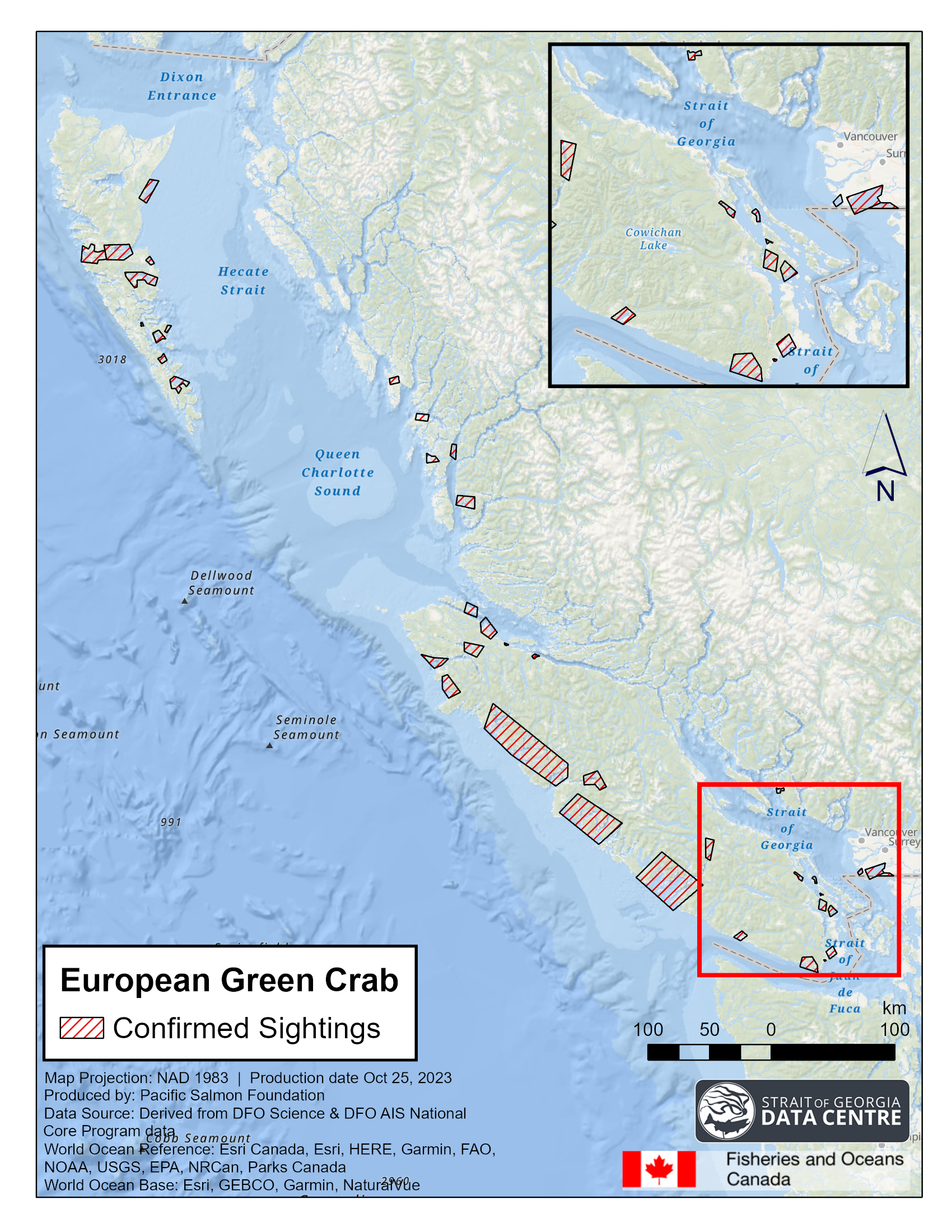
The European Green Crab is one of the world’s 10 most unwanted species.
This aggressive invasive crab competes for prey and has the potential to upset the overall balance of our local marine ecosystem. European Green Crabs feed on a variety of intertidal animals, including oysters, mussels, clams, small fish, and juvenile crabs. They’ve also been known to disrupt eelgrass beds (important habitat for young salmon) and can destroy shellfish habitat.
We’re concerned that they may be spreading into Howe Sound.
Howe Sound (Átl’ka7tsem) and the Squamish River Estuary (Skwelwil’em) are home to an abundance of species, including native shore crabs, juvenile salmon, seabirds, shellfish, rare glass sponge reefs, endangered rockfish, and much more. A European Green Crab infestation could significantly threaten the unique marine wildlife in this area.
European Green Crabs have recently been found in Boundary Bay (just south of Vancouver) and on Salt Spring Island (near the entrance of Howe Sound). Emergency responses are underway to address established European Green Crab populations on the west coast of Vancouver Island, in Haida Gwaii, and in Washington State.
European Green Crabs have a long early life (larval stage) of 50 to 80 days, when they drift in the ocean current before settling to the bottom. The adult green crab is also very hardy and can survive out of the water for over 5 days, hiding in fishing gear and equipment or, at the bottom of crates, buckets and boats.
European Green Crab are spreading fast. See for yourself – have a look at the animation on the Strait of Georgia Data Centre’s website.
Despite the European Green Crab’s ability to invade, there is hope! If new European Green Crab populations are detected before they get too established, it is much more likely that the issue can be addressed and native ecosystems can be protected. That’s where monitoring programs like Crab Team come in!

Volunteering with Crab Team
Recruitment for the 2025 Crab Team season is now complete! Please check back in March 2026 for the next opportunity to join, and follow us on social media or sign up for our newsletter for updates.
Alternatively, indicate your interest in volunteering ahead of time by submitting the form found on our volunteering page (select “Invasive species inventory”). We will reach out when 2026 Crab Team recruitment begins!
Sampling involves setting multiple crab traps at pre-determined sites, and then returning 24 hours later to collect & record data.
Volunteers should be comfortable carrying a small amount of gear over uneven terrain, occasionally working in imperfect weather conditions, walking in the mud, and handling all sorts of cool estuary critters.
All materials, training, and assistance at the sites will be provided by our team – no previous experience in ecological monitoring or marine biology is required.
This is a fantastic opportunity to gain experience in the field, have fun outdoors in the mud, and help to protect Howe Sound’s biodiversity.

More information
We need to know if this invasive crab has found its way to Howe Sound. In 2021, in collaboration with Fisheries and Oceans Canada (DFO), we launched a European Green Crab monitoring program based out of Squamish – Crab Team. Check out the results from 2021, 2022, 2023, and 2024.
Four Crab Teams, each with 4 volunteers, conduct sampling sets once a month per team. Sets are scheduled on 2 consecutive dates, scheduled according to low tide times. Each day of sampling takes approximately 1-2 hours to complete, depending on how many species are caught, if we’re training, etc.
For example, you might be scheduled to sample on Saturday July 15th , from 9:30 – 11:00AM, and then again on the following day, Sunday July 16th, from 10:45 AM to 12:45 PM. That would be your only commitment in July, and the following month, times/dates would be different. You will sample at the same location each month.
Have we ‘pinched’ your interest?
Recruitment for the 2025 European green crab monitoring season is now complete. Be shore to sign up for our newsletter and follow us on social media to stay tide to our efforts. Both are sea-soned with the latest news, so you don’t miss the boat again!


Questions?
Check out the FAQ below or email crabteam@ssisc.ca
- Where is the sampling being done and how do I get there?
Two of our 4 sites will be near downtown Squamish, and you can arrive there by walking, driving, biking, or other transport. Our other 2 sites will be located at Furry Creek and Porteau Cove, so you will need to drive or carpool with other volunteers. You can find a map of our planned 2024 sites here. Volunteers will sample at the same site for the duration of the monitoring season. - Do I need a car?
While 2 of our sites are accessible by walking / biking, we do have a fair amount of gear to transport from our storage locker to the site, and then to a washing station. For this reason, access to a car is preferred. We may be able to work out carpooling with other volunteers, but no guarantees.
-
- I am only available on the weekends. Can I still apply?
Yes! We have sampling set dates available on weekends. - I may not be available every month of the summer (July and August, for example). Can I still participate?
We have some flexibility in the trap monitoring schedule, and you will know the trapping dates for the entire season in May. However, if you plan on being away for several months on end, this may not be the volunteer project for you. - What’s the expected time commitment like?
• Approximately 1 hour to complete the 2 online courses, in April/May (exact date TBD).
• 1-2 hours during the daytime on two consecutive days each month. Factor in driving time depending on where you live!
• The exact time of day and date will likely be different each month, based on the tides, but there is some flexibility in the schedule. You will indicate your personal availability from a list of potential dates when you apply.
- I am only available on the weekends. Can I still apply?
- I don’t have a background in biology or field work. Can I still participate?
Yes! All you need is an interest in nature, the environment, and the willingness to learn. We will provide all the training and resources you will need! - Do I have to provide my own tools or supplies?
No! We recommend that you dress for the weather and wear comfortable clothing you don’t mind getting a bit wet or muddy, but otherwise we will provide you will all the tools and supplies you will need. If you have your own waders to wear – awesome! - What are the chances that I get selected to be on a Crab Team?
We get a lot of interest in this program, which we absolutely love to see! Volunteers with lots of availability to sample have a higher chance of being selected (this makes it much easier to assemble teams). If you have car access, live in the Sea to Sky, or have previously volunteered with us, you may be more likely to be selected. However, we encourage you to apply regardless – the form will only take 5 min to complete! - What happens if I catch a Green Crab? Can I eat it?
Should we catch any European Green Crabs, they will be humanely stored and transferred to a SSISC staff member, and then a Fisheries & Oceans Canada representative. Any native species caught in the traps will be released back into the water. Volunteers are not permitted to keep specimens of any kind from the traps.
More questions? Email us at crabteam@ssisc.ca
Report a suspected EGC sighting
If you believe you have spotted a European Green Crab in Howe Sound (or anywhere on the west coast of BC), please submit a report to Fisheries and Oceans Canada by email to AISPACIFIC@dfo-mpo.gc.ca.
To enable identification and follow-ups, reports should include:
- a photograph
- the GPS location and date of the sighting
- a note of any distinguishing features.
Please also report any sightings in Howe Sound to SSISC via email: crabteam@ssisc.ca. Please include a photo, GPS location and date if possible!
Unsure if the crab you’re looking at is a European Green Crab? Check out our species profile and identification guide here.
Learn more about European Green Crab and its impacts:
- European Green Crab species profile page from Fisheries and Oceans Canada
- European Green Crab species profile page from Sea to Sky Invasives Species Council
- Impacts of European green crab in British Columbia webinar via ISCBC
- The Squamish Community Foundation’s blog post about SSISC’s EGC program
- Report a possible sighting of European Green Crab
2024 Summary
In 2024, the SSISC Crab Team returned for our fourth year strong of European Green Crab monitoring in Howe Sound. From May to September, our expanded team of keen volunteers monitored for crabs at the Mamquam Blind Channel, Cattermole Slough, and Furry Creek, plus a brand new site at Porteau Cove!
Thankfully, we can continue to say that we still haven’t found any evidence that European Green Crab have spread into the Sound. Additionally, we were able to continue and expand our collection of baseline data about the intertidal organisms native to the area.
You can read more updates from the 2024 season on our blog.
2023 Summary
In 2023, the SSISC Crab Team returned for the third year of European Green Crab monitoring in Howe Sound. Our awesome volunteers sampled at the Mamquam Blind Channel, Cattermole Slough, and Furry Creek once a month from June to September. They caught all sorts of native creatures, including Graceful Crabs, Dungeness Crabs, Pipefish, Flat Fish, Hermit Crabs, Gunnels, and plenty of Sculpins. We’re very happy to announce that, in 2023, we found no evidence that European Green Crab have spread into Howe Sound!
This year, we travelled to Williamsons Landing (north of Gibsons) to train staff from the Nicholas Sontag Marine Education Centre (NSMEC) on how to run their own European Green Crab monitoring program. We look forward to assisting NSMEC as they begin their first season of monitoring in 2024. The SSISC Crab Team will restart preventative monitoring work next spring, with the addition of a fourth site in Porteau Cove.
You can read more updates from the 2023 season on our blog.
- Crab Team volunteers in Howe Sound.
2022 Summary
In 2022, we continued with our second year of the European Green Crab Monitoring Program in Howe Sound. We expanded our program by adding another Crab Team and a new site – the Mamquam Blind Channel. Our 12 volunteers sampled at the Mamquam Blind Channel, Cattermole Slough, Squamish Estuary, and Furry Creek once a month at from April-September. They caught all sorts of neat creatures, including Graceful Crabs, Dungeness Crabs, Flat Fish, Hermit Crabs, Gunnels, and lots of Sculpins. You can read more updates from our 2022 season on our blog.
We’re pleased that in our second year of monitoring, in 2022, we found no evidence of European Green Crab in Howe Sound.
2021 Summary
In 2021, we launched our first year of the European Green Crab Monitoring Program in Howe Sound. We recruited 9 local volunteers as ‘community scientists’ to help us survey for European Green Crab in Howe Sound. This involved setting crab traps at 1 site in Furry Creek and 2 sites around the Squamish Estuary, and then returning 24 hours later to collect & record data. Volunteers sampled consistently once a month at these sites from May-September, catching (and releasing) lots of native fish and crabs.
We’re happy to announce that, in 2021, we found no evidence of European Green Crab in Howe Sound.
Thank you to our supporters!
We’d like to express our gratitude to the funders and donors who have supported this program over the last 3 seasons of monitoring. A huge thank you to Fisheries and Oceans Canada, the Squamish Community Foundation, TD Friends of the Environment, the Squamish Lillooet Regional District, BC Parks, and generous individual donors who have supported this work- we couldn’t have done it without all of you!

We also want to thank the following businesses for their donation of prizes for our Crab Team volunteers:

Support SSISC
We’re still working to secure long term funding for our EGC Monitoring Program, for 2024 and beyond. If you’re able to contribute to our hands-on learning experiences like the European Green Crab monitoring program (anything helps!), you can donate here.
Have we ‘pinched’ your interest? Here’s some useful links:
- Learn more about Crab Team and our monitoring efforts
- European Green Crab species profile page from Fisheries and Oceans Canada
- European Green Crab species profile page from Sea to Sky Invasives Species Council
- Impacts of European green crab in British Columbia webinar via ISCBC
- The Squamish Community Foundation’s blog post about SSISC’s EGC program
























































